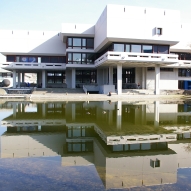Zusammenfassung
The form and evolution of multi-phase biomembranes are of fundamental importance in order to understand living systems. In order to describe these membranes, we consider a mathematical model based on a Canham-Helfrich-Evans two-phase elastic energy, which will lead to fourth-order geometric evolution problems involving highly nonlinear boundary conditions. We develop a parametric finite element ...
Zusammenfassung
The form and evolution of multi-phase biomembranes are of fundamental importance in order to understand living systems. In order to describe these membranes, we consider a mathematical model based on a Canham-Helfrich-Evans two-phase elastic energy, which will lead to fourth-order geometric evolution problems involving highly nonlinear boundary conditions. We develop a parametric finite element method in an axisymmetric setting. Using a variational approach it is possible to derive weak formulations for the highly nonlinear boundary value problems such that energy decay laws, as well as conservation properties, hold for spatially discretized problems. We will prove these properties and show that the fully discretized schemes are well posed. Finally, several numerical computations demonstrate that the numerical method can be used to compute complex, experimentally observed two-phase biomembranes.




 Altmetric
Altmetric